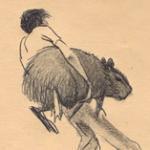Search the Community
Showing results for tags 'export'.
-
import { UnderlineText } from './underlineText.js'; let Application = PIXI.Application, loader = PIXI.Loader.shared, resources = PIXI.loader.resources, Sprite = PIXI.Sprite, text = PIXI.Text; let app = new Application({ width: window.innerWidth, height: window.innerHeight, antialias: true, transparent: false, resolution: 1, autoDensity: true }); document.body.appendChild(app.view); let underLine = new UnderlineText(null, [100, 385], null, null); app.stage.addChild(underLine); //app.loader.onError.add((error) => console.error(error)); Above is my index.js file. I have the module called UnderLineText. It doesn't work properly as it shows underline but not the text itself. It does count the width of the text, thus displaying the line underneath but I don't know how to make the text visible. Any ideas what I did wrong? P.S. I'm using PIXI js and I'm a newbie. class UnderlineText extends PIXI.Graphics { constructor(text, points, textFontSize, textColor) { super(); let t = this.textFontSize = textFontSize || 12; let s = this.lineWidth = 1; let c = this.textColor = textColor || "0xFFFFFF"; let ut = this.text = text || "Ողջույն"; let textStyle = { fontFamily: 'Arian AMU', fill: c, fontSize: t } let newText = new PIXI.Text(ut, textStyle); this.points = points; points[0] = newText.position.x; points[1]= newText.position.y; this.lineStyle(s, c); this.moveTo(points[0], points[1] + 13); this.lineTo(points[0] + newText.width, points[1] + 13); } } export { UnderlineText };
-
I'm not sure if this should be posted in https://forum.babylonjs.com/ or https://www.html5gamedevs.com/ so I'm posting on both. I have seen several posts and solutions to similar questions with the blender to babylon exporter (exporter V6.2.0, blender version 2.8) I've exported many animations from 3DS Max, but I'm fairly new to blender. I'm studying the Action editor, but obviously I'm not understanding something very fundamental. Basically, the issue is that the position of objects is different between the animation in blender and the .babylon I've read that you need to check "Only Currently Assigned Actions" or put a hyphen in the Action name. Autolaunch animations for each object. Apply transforms to each object. Set the location to where the object should be rotated about. Parent the objects to each other. Don't parent empties because you can set an empty to "Auto launch animations" All these things have helped tremendously. I'm still missing or not understanding something though. I've done my homework, but haven't figured it out. Any help would be greatly appreciated. Here is the playground link showing the issue. https://playground.babylonjs.com/#R82EL4#2 Here is a link to the .blend and .babylon files in dropbox https://www.dropbox.com/sh/fjdk4urwfckc5m9/AAAuDbBmwFtA466gAOylY7mTa?dl=0 In the world tab, Only Currently Assigned Actions is checked. Applied rotation and scale of parts. I set the location to where I want the part to rotate about. I select the redCube (Axis 1). Frame 10 I insert a LRS key. redCubeAction is created in the action editor Scrub to frame 40. rotate the redCube by -45 degrees on the x axis. and insert another key. The animation runs in blender and the .babylon as expected. All is good so far. I didn't bake the animation. It doesn't seem to make a difference. I select the blue cube (axis3) which is parented to the redCube. Click on New in the action editor. "Action" is created. I scrub to 50 and make a LRS key with blueCube selected. I scrub to 80, rotate blueCube along the X axis by +45 degrees and make another key. The robot is kind of squat there. The blueCube is at the end of the Red cube as a good robot should be. I play the animation in Blender and it runs as expected, but in the .babylon file, the blueCube is raised up a bit. Does anyone know why this happens and what I can do to prevent it? robotBlenderForForum.blend robotAnimation.babylon
-
- export
- babylon blender export
-
(and 3 more)
Tagged with:
-
Hi, I'm hoping you can share some ideas with me! I'm making web based games with Pixi.js and I'm having a bit of a hard time working with the graphics design team (this is not a developers vs designers issue!). I'm trying to find the best workflow that might help us both do our jobs faster, but I can't seem to find the right tool for it! The designers sketch and build the app in Photoshop, and I work in Typescript with Pixi. So... what we've tried so far was: they sketch up in PS and then generate all assets with TexturePacker, leaving me with a json file which I can easily import into my game. The downside of this is that I have to position every asset and create every container manually (or rather using a config file, but still that's kinda manual work). Our second attempt was that they sketch up in PS, then export that to Adobe Animate, and using the PixiAnimate plugin, they then create the files for me to use. This has improved our workflow, because I don't need to position anything nor create the containers, but there are still some flaws as they are not able to test interactive elements (they can't see how a button actually reacts unless I implement it), and I would love to not depend on Animate which seems fairly deprecated nowadays, and on an external plugin which is out of our control. Plus, designers (at least ours) do not think as programmers, and they don't make variable names easy for us. PixiAnimate creates objects using the instance name they put on Animate, but they don't follow any guidelines. If they have four items of the same group, they call them "item_1", "item2", "this_is_the_third_item", and "last_one". If there's a tool that can validate this prior to exporting (setting some kind of rules, like prefixes for elements), that would be awesome. So yeah, I'm asking for a magical tool. I know it doesn't exists, and I know some adjustments are necessary on both sides, but I'd love to hear from you guys, how do you work with your graphics team, what do they use and how do they deliver the assets to you! Thanks!
-
solved Exporting from 3dsMax error
fdeng posted a topic in Content creation (3dsMax, Maya, Blender, glTF)
When exporting from some 3dmax files, it always report such error: System.NullReferenceException: Object reference not set to an instance of an object. at Max2Babylon.BabylonExporter. isMaterialSupported Did anyone encounter this problem before, and how to fix it? -
Hi, I have noticed that there is a difference in displaying .glb files between desktop and mobiles e.g. on Facebook. The files exported from babylonjs.serializers using GLTF2Export.GLBAsync() or 3DS max + Babylon JS plugin has strange reflection despite of specular=0, roughness=1, metallic=0 etc. I have tried many combination with Std and PBR materials and I always have this strange reflection on mobiles. I decided to try Modo and the effect is much better. So probably you have a bug in babylonjs.serializers and 3DS max plugin. I have noticed that in attached file called "babylonJS.glb" which was exported from 3DS max "roughnessFactor" is 0.9 and should be 1.0 if I use standard material with specular = 0. GLB files: babylonJS.glb Modo.glb Screenshot from the smartphone (Android/iOS, the effect is the same), 3DS max + Babylon JS plugin and the same effect after using babylonjs.serializers.js GLTF2Export.GLBAsync() method: Screenshot from the smartphone when Modo was used (on smartphone the box is totally black - so the effect is actually perfect). And the effect which we can see on the desktop web browser (as you can see the file exported from Babylon JS is not totally black, but it should be. However the worst thing is this reflection on mobiles):
- 14 replies
-
I have a problem I would like to export my single page of phaser game in another ionic page but I have no result and the screen is still white. I have no error on the console I don't know what 's wrong with me
-
- ionic
- phaser game
-
(and 1 more)
Tagged with:
-
Hello Babylon community, When using the BABYLON.GLTF2Export feature, I noticed that textures I mirror horizontally (via diffuseTexture.vScale = -1) do not change the glTF export as desired. Is this a known / accepted limitation or is there a misunderstanding from my side? Also any workaround is appreciated (so far I mirror the texture again manually after exporting them). Here a playground example to illustrate the problem: http://www.babylonjs-playground.com/#1GXSPK#17 Uncomment line #11 ( = // oStandardMaterialHightlighter.diffuseTexture.vScale = -1;) and compare the export results. Any help is appreciated (pinning @kcoley as you helped me so greatly last time)
-
Hi everyone, I start learning to use your software because he is really interesting and usefull but I encounter a serious problem with blender export animation. So I create some asset and put them little simple, but when I export the file and put it in babylon, all the animation are compiled in one and apply in all the assets; Let me show you with screen shots. As you can see in the first screen the asset have their own animation but in the 2 and 3 screenshot they have all animation of all the assets Is there a solution about that ? I'll be glad if someone as an answer, thanks you very much and have a nice day.
-
Hello all, I am trying to learn Babylon.js by making a simple game. But I have a problem. Some of the tiles I drew in Max2017 export wrong to babylon.js. Export to Substance Painter using a .FBX works and gives no problems. They are simple models and I don't see any faults, I have attached an image how it looks in Max and made a playground how it looks in Babylon.js, at some angles you can see through the faces to see the parts behind it. http://www.babylonjs-playground.com/#1UQADD#6 Can anybody see what I am doing wrong?
- 4 replies
-
- mesh
- transparancy
-
(and 2 more)
Tagged with:
-
Hello Babylon community, I have been working with the BABYLON.GLTF2Export feature (which is by the way great to have!!!), and noticed an odd behavior of which I am not sure if it is intended. Check out this playground: http://www.babylonjs-playground.com/#1GXSPK#16 It will create a simple scene with a texture and download the following 3 files to your computer: MyFile.gltf MyFile.bin _textures_BJS-logo_v3.png.png So texture image files are renamed during export by their folder path and file extension (in our example from "./textures/BJS-logo_v3.png" to _textures_BJS-logo_v3.png.png ") If I then try to open / drag and drop these in the sandbox https://sandbox.babylonjs.com, I get the following error message: #/images/0/uri: Failed to load './textures/BJS-logo_v3.png.png': 0 Changing line 169 in the file "MyFile.gltf" From: "uri": "./textures/BJS-logo_v3.png.png" To: "uri": "_textures_BJS-logo_v3.png.png" makes it work again in the sandbox and other software. Maybe the intention here is to indicate with "_textures_" that the image texture was originally in the sub-folder texture, but you cannot open the gltf-file any more like that. In my opinion the BABYLON.GLTF2Export should either Leave the texture file names as is (e.g. "./textures/BJS-logo_v3.png") so that as a user I have to save the gltf in the correct folder (typically relative to the Babylon HTML-app) and NOT include them in the export (i.e. only two files are downloaded), or Include the textures in the export but fix the uri to the correct relative value. Just a proposal to save others the time I spent figuring this out.
-
My scene meshes partially created uses ribbons. Orange meshes on picture. All meshes displayed good on screen , but when i try to export scene meshes to OBJ file, then ribbons created meshes not export to result file, without errors. Just nothing, except usual created meshes(black/gray on picture) in result OBJ file , after importing uses freecad/meshlab. And file size is tiny (looks like ribbons just not added to export flow). while i try export only ribbons , in import time i see error "no vertex field found" and file include only elements heading exported_wheel(4).obj
-
for example i have: html button <button id="objButton" onclick="fileExport()"></button> result of var objtext = BABYLON.OBJExport.OBJ(OBJexport); // this is *.obj file syntax with meshes from scene what syntax should i use inside fileExport function, that popup window savefile in browser? I have syntax with link a href which work , but i need use button, because the program gui with buttons usually, but not with text links. this is a href syntax: function download(text, name, type) { var a = document.getElementById("a"); var file = new Blob([text], {type: type}); a.href = URL.createObjectURL(file); a.download = name; } after this, click link and can save file. I need button way. If possible not way where button press call a.click()
-
Hello - can anyone explain how to create a simple blender object with 2 or more animations, for exporting to babylon? I can get a basic animation to work, but more than 1 is a mystery. I can't find any tutorials that explain this. I just want a really simple cube that moves sideways and up and down, as separate animations. Then I'll be able to understand how to setup multiple animations in blender, ready to be used in babylon. Thanks
-
Hi there, i am currently trying to export just a model from blender using the babylonJS exporter provided on git. The installation worked. In the documentation there is an export property window shown where i can check what i want to export. But i cant't find this window? If i export as babylon there is just written no properties. I tried with Blender 2.79 2.76 2.73 (64/32 bit) and Exporter Version 5.6 and 5.5 The reason for this is that i want to export without the automatic texture bake... Can anyone please help me out? Best Regards
-
Is there any way to export a babylonjs scene as a gltf rather than the ".babylon" format?
-
Using latest blender 2.79 and latest exporter from Babylon team: Camera and a cube animated 1-990 frames. On export, two things wrong occur: cube position array is cloned to camera, ensuring camera playback is dead center of cube once returned to blender, all /most keyframes sometimes deleted. As a diagnostic task, I removed the box to only export the camera, which resulted in the camera keyframes being deleted and no file exported at all, resulting in a large diagostic failure log. It appears the exporter deletes the camera and keyframes during export, then attempts to export empty data ( list out of range ) For files see : https://github.com/BabylonJS/Exporters/issues/50
-
I've been googling around for a week trying to find the answer without much success. I basically have a blender file which I try to export with animation to Babylon.js. First I made the mesh animate in Blender which doesn't work since I use need skeletons to animate. Then I created an armature with a bone and redid all the animations. Now I binded the object/mesh to the bone and the animation looks well and all in Blender. Even when I export the .babylon file I see the `skeletons: []` being defined in the file. But upon importing there are no skeletons included. The connection between the mesh and skeleton is through "childOf: skeleton" which might not be ideal. However the only other solution I've found that might work is putting bones everywhere with automated weight and hope that all meshes gets moved in the animation; which they don't. I've also done Bake Action prior to exporting. I simply wish to get the animation from Blender into Babylon.js. There might be something obvious I'm missing so help is appreciated. controller.babylon controller.log
-
Hi, Is it possible to control image format export for 3d max materials (force jpg, png for example) somehow? As for physics material (pbr) it produces png right now for me even without any transparency. Thank you in advance.
-
It would be nice to have Panda 2 editor to be able to export to Cordova, Ejecta or similar frameworks.
-
Hello, I'm a newbee at babylonjs and I'm currently learning the BJS engine as well as the blender for 3d modelling. I have a problem when I import a .babylon file that I have created in blender. What I want to do is after loading the model, to set an ArcRotate camera to the model. I'm using this propery in order to set the target: var assetsManager = new BABYLON.AssetsManager(scene); var boatMeshTask = assetsManager.addMeshTask("BoatTask", "Boat", "assets/Boat/", "tugboat.babylon"); boatMeshTask.onSuccess = function (task) { model = task.loadedMeshes[0]; model.position.z = -80; model.position.y = 3; camera.target = model; camera.lockedTarget = model; }; assetsManager.load(); ... The problem is that when I try to apply a rotation to the model at Z axis, my skybox rotates as well. I'm using BABYLON.Space.LOCAL. For translation I'm using the following code: model.rotate(BABYLON.Axis.Z, rotationAngle, BABYLON.Space.LOCAL); This is the model I try to load: https://cbml.ddns.net/index.php/s/gaRUgfazEjad4b7 Any suggestion;
-
Hello, What is the simplest OR best way to get a cube to copy a footIK bone transforms (location/rotation) AND export successfully? When the right foot IK is posed, the cube mimics the transform in Blender, but on export the cube has no animation. How to get the cube to mimic the footIK transform? NOTE: not a case of applying transforms (did that).
-
How to perfectly set up all possible PBR properties (channels and values supported by Babylon PBR material ) in 3D max such that it exports to Babylon perfectly in a manner that uses the full potential of Babylon PBR materials? (Without requiring to set any PBR properties by code or by using editor.babylonjs.com ) I am basically looking for best workflow method for producing realistic Babylon scenes (which have PBR materials for all meshes) using 3D Max. Any common pitfalls/suggestions/tips ?
-
QUESTION: What are the minimum steps required to get a bone to export from blender and to be visualized with Debug.SkeletonViewer? Having trouble making a cube add a bone and then export to babylon. After a bunch of variations I see why... there are many steps: Applied: Object->Apply->Location & Rotation & Scale. And ensured Camera Icon is on Armiture (exporting). Weight Painted. Or setParent-> Auto Weights. And added Armiture modifier... still no bones. Tried two different loading types, two different export types (Tower of Babel), and then... #3 glTF. Fabulous! I'll leave the tips that I find below. GOAL: open blender > add 1 bone inside a cube or tube and > export to .babylon > then see bone with Debug.SkeletonViewer. PURPOSE: to run a bunch of test animations on bones (at runtime). CONTEXT: Blender version (2.78) and updated the exporter (babylon.js ver 5.4.2). Also Tower of Babel, and glTF exporter 1.0. UPDATE: glTF animations look promising. I'll provide answer here for minimum steps to animate GLTF Blender Export. Any tips of things to try in this experiment? Thx.
-
Does anyone have experience using the Tower of Babel exporter with the Mac version of Blender? My test scenes fail with the following log error (in both Bforartists and the "mainline" Blender app). Is there perhaps a file-writing peculiarity under OS-X? I'm too weak at Python to dig any deeper before reaching out, I'm afraid... [snip] ========= Writing of files started ========= ========= An error was encountered ========= File "/Users/me/Library/Application Support/Bforartists/2.79/scripts/addons/tower-of-babel/js_exporter.py", line 177, in execute self.to_script_file() File "/Users/me/Library/Application Support/Bforartists/2.79/scripts/addons/tower-of-babel/js_exporter.py", line 217, in to_script_file self.world.initScene_script(file_handler, typescript_file_handler, self.needPhysics, self) File "/Users/me/Library/Application Support/Bforartists/2.79/scripts/addons/tower-of-babel/world.py", line 84, in initScene_script file_handler.write(indent + 'scene.fogMode = ' + self.fogMode + ';\n') ERROR: Can't convert 'int' object to str implicitly ========= end of processing ========= elapsed time: 0 min, .0047 secs test_scene.blend










